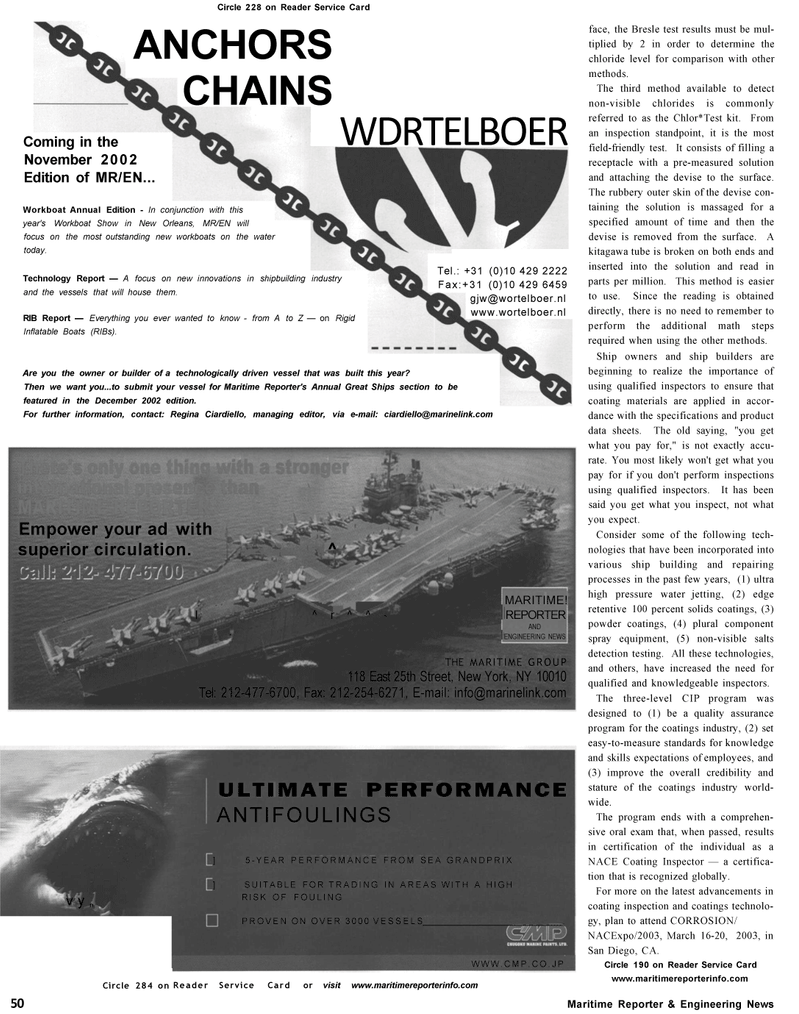
Page 51: of Maritime Reporter Magazine (October 2002)
Read this page in Pdf, Flash or Html5 edition of October 2002 Maritime Reporter Magazine
Circle 228 on Reader Service Card
ANCHORS
CHAINS
Coming in the
November 2002
Edition of MR/EN...
Workboat Annual Edition - In conjunction with this year's Workboat Show in New Orleans, MR/EN will focus on the most outstanding new workboats on the water today.
Technology Report — A focus on new innovations in shipbuilding industry and the vessels that will house them.
RIB Report — Everything you ever wanted to know - from A to Z — on Rigid
Inflatable Boats (RIBs).
WDRTELBOER
Tel.: +31 (0)10 429 2222
Fax:+31 (0)10 429 6459 [email protected] www.wortelboer.nl
Are you the owner or builder of a technologically driven vessel that was built this year?
Then we want you...to submit your vessel for Maritime Reporter's Annual Great Ships section to be featured in the December 2002 edition.
For further information, contact: Regina Ciardiello, managing editor, via e-mail: [email protected]
Empower your ad with superior circulation. ^
MARITIME!
I ^r^^ - REPORTER
AND ' " ENGINEERING NEWS
THE MARITIME GROUP 118 East 25th Street, New York, NY 10010
Tel: 212-477-6700, Fax: 212-254-6271, E-mail: [email protected] vy„
ULTIMATE PERFORMANCE
ANTIFOULINGS ] 5-YEAR PERFORMANCE FROM SEA GRANDPRIX ] SUITABLE FOR TRADING IN AREAS WITH A HIGH
RISK OF FOULING
PROVEN ON OVER 3000 VESSELS .
WWW.CMP.CO.JP
Reader Service Card or visit www.maritimereporterinfo.com face, the Bresle test results must be mul- tiplied by 2 in order to determine the chloride level for comparison with other methods.
The third method available to detect non-visible chlorides is commonly referred to as the Chlor*Test kit. From an inspection standpoint, it is the most field-friendly test. It consists of filling a receptacle with a pre-measured solution and attaching the devise to the surface.
The rubbery outer skin of the devise con- taining the solution is massaged for a specified amount of time and then the devise is removed from the surface. A kitagawa tube is broken on both ends and inserted into the solution and read in parts per million. This method is easier to use. Since the reading is obtained directly, there is no need to remember to perform the additional math steps required when using the other methods.
Ship owners and ship builders are beginning to realize the importance of using qualified inspectors to ensure that coating materials are applied in accor- dance with the specifications and product data sheets. The old saying, "you get what you pay for," is not exactly accu- rate. You most likely won't get what you pay for if you don't perform inspections using qualified inspectors. It has been said you get what you inspect, not what you expect.
Consider some of the following tech- nologies that have been incorporated into various ship building and repairing processes in the past few years, (1) ultra high pressure water jetting, (2) edge retentive 100 percent solids coatings, (3) powder coatings, (4) plural component spray equipment, (5) non-visible salts detection testing. All these technologies, and others, have increased the need for qualified and knowledgeable inspectors.
The three-level CIP program was designed to (1) be a quality assurance program for the coatings industry, (2) set easy-to-measure standards for knowledge and skills expectations of employees, and (3) improve the overall credibility and stature of the coatings industry world- wide.
The program ends with a comprehen- sive oral exam that, when passed, results in certification of the individual as a
NACE Coating Inspector — a certifica- tion that is recognized globally.
For more on the latest advancements in coating inspection and coatings technolo- gy, plan to attend CORROSION/
NACExpo/2003, March 16-20, 2003, in
San Diego, CA.
Circle 190 on Reader Service Card www.maritimereporterinfo.com
Maritime Reporter & Engineering News
Circle 284 on 50

 50
50

 52
52
